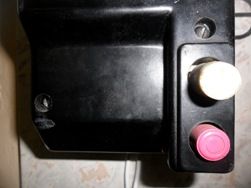Categories: Electrician Secrets, Electrical connection of equipment
Number of views: 19608
Comments on the article: 1
How to ensure reliable and safe switching of powerful power consumers in everyday life
 A conventional switch is not suitable for switching on a load of 2 kW or more. The article talks about how to solve this problem.
A conventional switch is not suitable for switching on a load of 2 kW or more. The article talks about how to solve this problem.
What needs to be done to turn on the light bulb? Just flip the switch. Nowhere is easier. Well, what needs to be done to turn on the five-kilowatt boiler? Also click the switch? Alas, if this switch is connected directly to the power circuit, then it will exist for a very short time. His contacts are designed for a maximum of 10 amperes maximum. Even if you consider that the switched load is purely active and the power factor is close to unity, these 10 amperes will amount to only two and a few kilowatts for a single-phase load.
Not really something and you will run into such a reserve for power. And what to do? After all, power consumers with a capacity of more than two kilowatts are not so rare in everyday life. Of course, many of them are equipped with their own switches, but, unfortunately, not all.
Some find a solution to the problem, which at first glance seems simple and obvious. Just a 16-amp socket is installed near the power receiver, and to turn on the plug, plug it into the socket, and to turn it off, pull it out. So what? 16 amperes is already about 4 kilowatts, quite a serious load - all at par. Yes, only the outlet when working in such conditions burns out and melts very quickly. It is designed to withstand a load of 16 amperes, and not to tear it and the resulting electric arc.
Some monsieurs are so knowledgeable in perversions that, for example, they turn on / off a large current load by screwing and unscrewing plugs or inserting and pulling out fusible inserts in switchboards. It is difficult to even comment on such examples. This is a vivid example of human laziness, which makes people work even harder and at the same time risk their own health and the condition of their equipment.
 A more reasonable and simple solution seems to be installation of a circuit breaker in the power circuit, which will perform the functions of an ordinary switch. In principle, this does not contradict any rules. For any load, you can choose the appropriate circuit breaker, but there are two "buts" that you can not forget about.
A more reasonable and simple solution seems to be installation of a circuit breaker in the power circuit, which will perform the functions of an ordinary switch. In principle, this does not contradict any rules. For any load, you can choose the appropriate circuit breaker, but there are two "buts" that you can not forget about.
Firstly, such a circuit breaker will withstand a very large number of switching under load. So that his contacts do not burn, the rating of the machine must be selected with a substantial margin, at least one step higher. That is, if the rated load, for example, is 23 amperes, then the switch must be selected not at 25, but at 32 or even at 40 amperes.
Secondly, it is no longer worth hoping that this circuit breaker can provide us with overcurrent protection. Therefore, the circuit switched by this switch must be additionally protected by another device, for example, another automatic machine, selected more carefully.
 The academic solution to the problem is installation of an electromagnetic starter or contactor with a two-button post ("start-stop"). And if bulky contactor when turned on / off, it makes loud pops, and its coil may hum a little during operation, then the compact starter can turn on without these unpleasant noise effects.
The academic solution to the problem is installation of an electromagnetic starter or contactor with a two-button post ("start-stop"). And if bulky contactor when turned on / off, it makes loud pops, and its coil may hum a little during operation, then the compact starter can turn on without these unpleasant noise effects.
In addition, there is a modification of starters that have a full-time plastic or metal case, which already has the coveted “start” and “stop” buttons. Such a starter itself can be equipped with an overload relay (the so-called "heat supply"), which will also not be out of place.
The conclusion is this: for switching a significant current load in domestic conditions, either a large circuit breaker or a launch station on an electromagnetic starter is best suited.
Alexander Molokov
See also at bgv.electricianexp.com
:
